Which types of Japanese knives are there?
In recent years Japanese kitchen knives have grown in popularity. We understand why! They are the cream of the crop. Razor-sharp and a sight for sore eyes. But did you know that there are many different types of Japanese kitchen knives? This is because the Japanese use a specific knife for each purpose. A knife to cut vegetables, another knife to cut meat and yet another knife to finely fillet fish. In this overview you will find all different Japanese kitchen knives that are a part of our range.
Santoku
A santoku is the Japanese version of the chef's knife. The word santoku means: three qualities. According to some, this refers to the cutting, crushing and scooping qualities that the santoku is known for. Others say it stands for meat, fish and vegetables. The three ingredients that can easily be cut with a santoku. All we know is that a santoku is an incredibly versatile kitchen knife that is perfect when cutting, crushing and scooping meat, fish and vegetables.
You can recognize a santoku by its high blade where the spine of the blade only tapers towards the tip at the end of the blade. A santoku doesn't 'rock' on the surface but moves diagonally from back-top to front-down. The knife constantly remains in a horizontal position
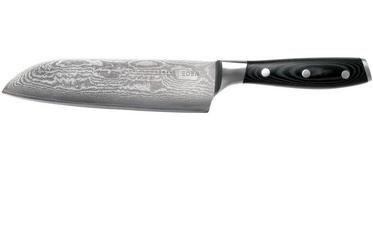
Nakiri
A Nakiri is a traditional Japanese vegetable knife. You use a nakiri to effortlessly cut carrots, cucumber, cabbage and many other types of vegetables. But also finely cutting herbs is a piece of cake.
You can recognize a nakiri by its rectangular blade which allows you to use the entire cutting edge. The edge is wafer-thin and razor-sharp. With it you cut much finer and more precisely than with a normal knife.
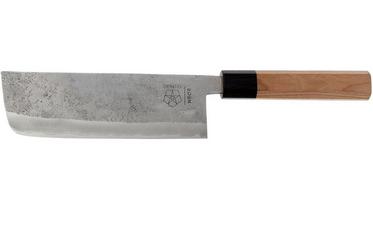
Yanagiba
A yanagiba is a long, Japanese kitchen knife that is used to cut sashimi, raw fish. It is sometimes also called a type of kitchen katana, after the famous Japanese sword. Makes sense when you look at the shape of the blade: long, thin and with a pointed tip. The edge is always enhanced with a one-sided grind.
Because of the long blade you can quickly cut through a piece of meat or fish in one go. As such you prevent using a sawing movement and end up with the best results. This is a real must-have for sushi enthusiasts. Amazing when cutting through maki rolls and to cut sashimi for on nigiri.
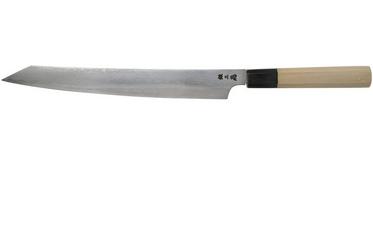
Sujihiki
The sujihiki is the double-sided grind alternative for a yanagiba. With the long blade of a sujihiki you can effortlessly cut wafer-thin, straight slices of meat and fish. The needle-like shape makes it perfect to reach underneath the fat to remove unwanted fat or connective tissue from larger pieces of meat such as ribeye or pork loin. You can also easily use this knife to fillet fish. Do, however, keep in mind that this knife is not very fond of bones
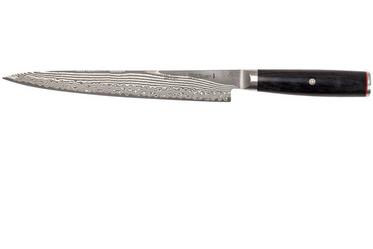
Petty
The petty is a Japanese version of the paring knife. Petty might mean inferior. This knife most certainly isn't. Because of its slim shape you can use this knife to peel vegetables and fruit or for the smaller cutting jobs in the kitchen. As such it is not that surprising that many professional chef's use this knife on a daily basis.
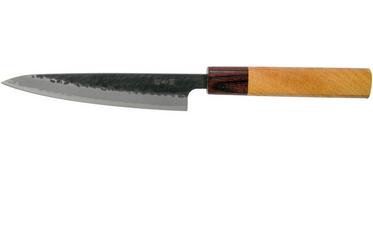
Shotoh
The name shotoh comes from the word 'shotoh', the Japanese word for small sword. When you look at the shape of the blade you understand why. This modern looking Japanese kitchen knife is slightly bigger than your average paring knife. Great if you prefer using a larger blade when you cut, peel and clean vegetables and fruit. This knife is great for the finer cutting jobs, and not for the more demanding tasks in the kitchen.
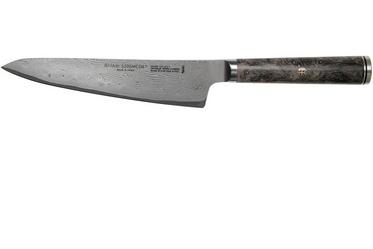
Deba
Deba knives are Japanese carving knives. Designed to fillet fish (bones and vertebrae) and shellfish. To be able to withstand breakage, the blade is somewhat thicker than the blade of a carving knife and the edge is often sharpened on one side while the other is hollow. The deba knives with a one-sided grind can only be used by right-handed users. Are you a left-handed user? If so use a deba knife with a double-sided grind.
You immediately recognize a deba knife by its remarkable blade. The spine of the blade is rounded and ends up in a sharp tip.
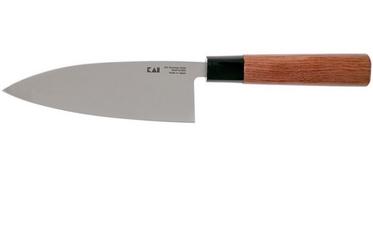
Gyuto
A gyuto is an average-sized knife that is mostly used to finely cut meat and large vegetables. When preparing vegetables you use the knife by making a chopping movement near the heel of the knife. Use the tip to create a fine cut. There is usually a slope from the heel of the knife to the tip, causing the wrist to point down and the shoulder to move up as you use the knife. The size of the blade varies between 21 and 27 cm. A 21 cm blade is more flexible while the 24 cm blade is more for general use. The 27 cm blade has more cutting power, but is much larger and longer, making it more difficult to use

There are many more Japanese knives we haven't listed. Think of Kiritsuke's, Bunka's and Takobiki's. And how about sashimi knives. It is because 'sashimi knife' is the collective term for all long, Japanese kitchen knives that can be used when cutting sashimi. Yanagiba's and Sujihiki's are also sashimi knives. Check out all sushi and sashimi knives or discover all Japanese kitchen knives here.







